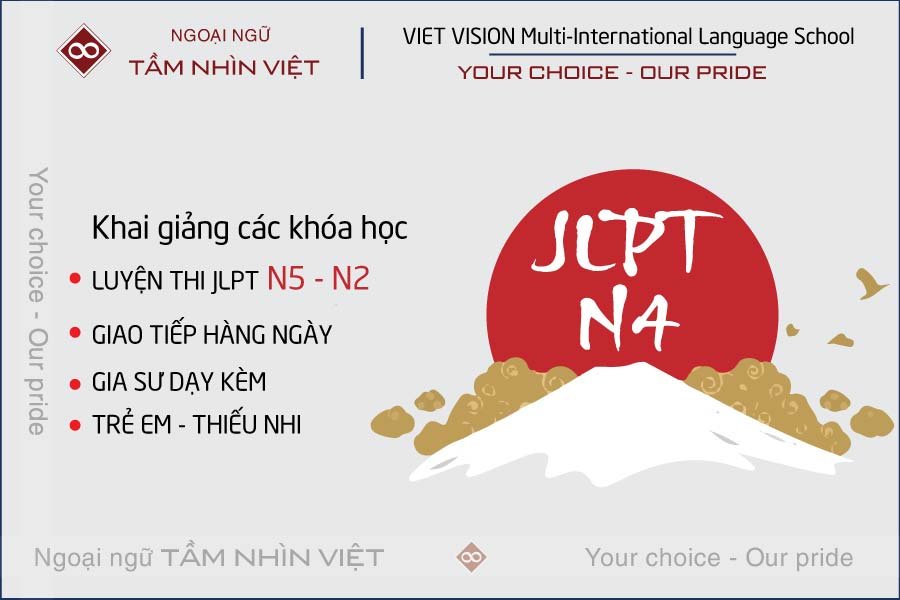Hôm nay chúng ta sẽ đến với Bài số 24 – Từ vựng tiếng Nhật Minna No Nihongo + Giải thích ngữ pháp.
Trong bảng từ vựng bên dưới có chữ Hiragana, katakana và Kanji và diễn giải bằng tiếng Anh. Nếu bạn nào chưa biết các bảng chữ cái trong tiếng Nhật thì có thể xem lại tại đây: Tổng hợp các bảng chữ cái trong tiếng Nhật
Trong bài học, ngoài từ vựng còn có phần giải thích ngữ pháp rất cặn kẽ. Tuy nhiên, một điều lưu ý là bài học được thiết kế dành cho các bạn có nền tảng kiến thức tiếng Anh tốt. Nếu bạn nào không tự tin, có thể sử dụng ứng dụng Google Translate để dịch thành tiếng Việt nhé!
- Có thể bạn quan tâm: Khóa học tiếng Nhật luyện thi chứng chỉ JLPT từ N5 – N3 tại Ngoại ngữ TẦM NHÌN VIÊT

# Bảng từ vựng tiếng Nhật Minna No Nihong
| NO | WORD | KANJI | MEANING |
| 1 | くれます | give (me) | |
| 2 | つれていきます | 連れて行きます | take (someone) |
| 3 | つれてきます | 連れて来ます | bring (someone) |
| 4 | おくります[ひとを~] | 送ります[人を~] | escort (someone), go with |
| 5 | しょうかいします | 紹介します | introduce |
| 6 | あんないします | 案内します | show around, show the way |
| 7 | せつめいします | 説明します | explain |
| 8 | いれます[コーヒーを] | make (coffee) | |
| 9 | おじいさん/おじいちゃん | grandfather, old man | |
| 10 | おばあさん/おばあちゃん | grandmother, old woman | |
| 11 | じゅんび[~します] | 準備[~します] | preparation (prepare) |
| 12 | いみ | 意味 | meaning |
| 13 | [お]かし | [お]菓子 | sweets, snacks |
| 14 | ぜんぶ | 全部 | all |
| 15 | じぶんで | 自分で | by oneself |
| 16 | ほかに | besides | |
| 17 | ワゴンしゃ | ワゴン車 | station wagon |
| 18 | [お]べんとう | [お]弁当 | box lunch |
| 19 | ははのひ | 母の日 | Mother’s Day |
# Giải thích một số ngữ pháp tiếng Nhật trong bài học![]()
1. くれます
You learned that あげますmeans “give” in Lesson 7. This verb cannot be used when somebody else gives something to the speaker or the speaker’s family, etc. (x さとうさんはわたしにクリスマスカードをあげました). In this caseくれます is used.
わたしは佐藤さんに花をあげました。
I gave flowers to Ms. Sato.
佐藤さんはわたしにクリスマスカードをくれました。
Ms. Sato gave me a Christmas card.
佐藤さんは妹にお菓子をくれました。
Ms. Sato gave candies to my younger sister.
2.
Vて-form |
あげますもらいますくれます |
あげます, もらいますand くれますare also used to refer to the giving and receiving of actions as well as those of things. They indicate who is doing that act for whom, while also expressing a sense of goodwill or gratitude. In this case, the act is expressed by the て-form.
1) Vて-formあげます
Vて-formあげます indicates that one does something for somebody with a sense of goodwill.
わたしは木村さんに本を貸してあげました。
I lent Ms. Kimura a book.
When the speaker is the actor and the listener is the receiver of the act, this expression could give the impression that the speaker is being patronizing. You are, therefore, advised to avoid using this expression directly to someone whom you do not know very well or who is senior or superior to you. You may use it to someone with whom you have a very close, friendly relationship. So, when you offer assistance to someone who is not very close, Vます-form ましょうか (see Lesson 14,6) is used.
タクシーを呼びましょうか。
Shall I call a taxi for you?
手伝いましょうか。
May I help you?
2) Vて-formもらいます
わたしは山田さんに図書館の電話番号を教えてもらいました。
Mr. Yamada told me the telephone number of the library.
This expression conveys a sense of gratitude on the part of those who receive a favor.
3) Vて-formくれます
母は[わたし]にセーターを送ってくれました。
My mother sent me a sweater.
Like Vて-formもらいます, this expression also conveys a sense of gratitude on the part of those who receive a favor. The difference is that Vて-formもらいます has the receiver of the act as the subject of the sentence, while Vて-formくれます has the actor as the subject of the sentence, implying the actor (the subject) voluntarily takes the action. The receiver of the act in the latter case is often the speaker and わたし(the receiver) に is often omitted.
3. N (person) がV
すてきなネクタイですね。
ええ、佐藤さんがくれました。
That’s a nice tie, isn’t it?
Yes. Ms. Sato gave it to me.
You present a topic, saying すてきなネクタイですね. Responding to it, your partner in conversation gives a piece of information on the topic which is unknown to you, [このネクタイは]さとうさんがくれました. The subject of the sentence giving new information is indicated by が.
4. Interrogative がV
You learned that when the subject is questioned, it is indicated byが in あります/いますsentences (Lesson 10) and adjective sentences (Lesson 12). This is also the case for verb sentences.
だれが手伝いに行きますか。
カリナさんが行きます。
Who will go to give him a hand?
Ms. Karina will.
Như vậy, chúng ta đã kết thúc Bài số 24 – Từ vựng tiếng Nhật Minna No Nihongo + Giải thích ngữ pháp
Hãy tiếp tục theo dõi các bài học về từ vựng tiếng Nhật trong sách giáo trình Minna No Nihongo tại đây: Tổng hợp các bài học từ vựng tiếng Nhật theo giáo trình Minna No Nihongo
Bonus: Sách hiện có bán trên các kênh thương mại điện tử như Amazon, Tiki, Lazada, nhà sách Fahasa…
Có nhiều bạn sẽ thắc mắc là tại sao phải học từ vựng từ quyển sách giáo trình Minna No Nihongo? Nếu bạn chưa biết thì mình sẽ nói đơn giản như sau: Đây là giáo trình tiêu chuẩn quốc tế cho bất kì ai học tiếng Nhật Bản, được giảng dạy ở hầu hết các trường đại học trên toàn thế giới.
Cảm ơn bạn đã quan tâm và theo dõi bài học!
